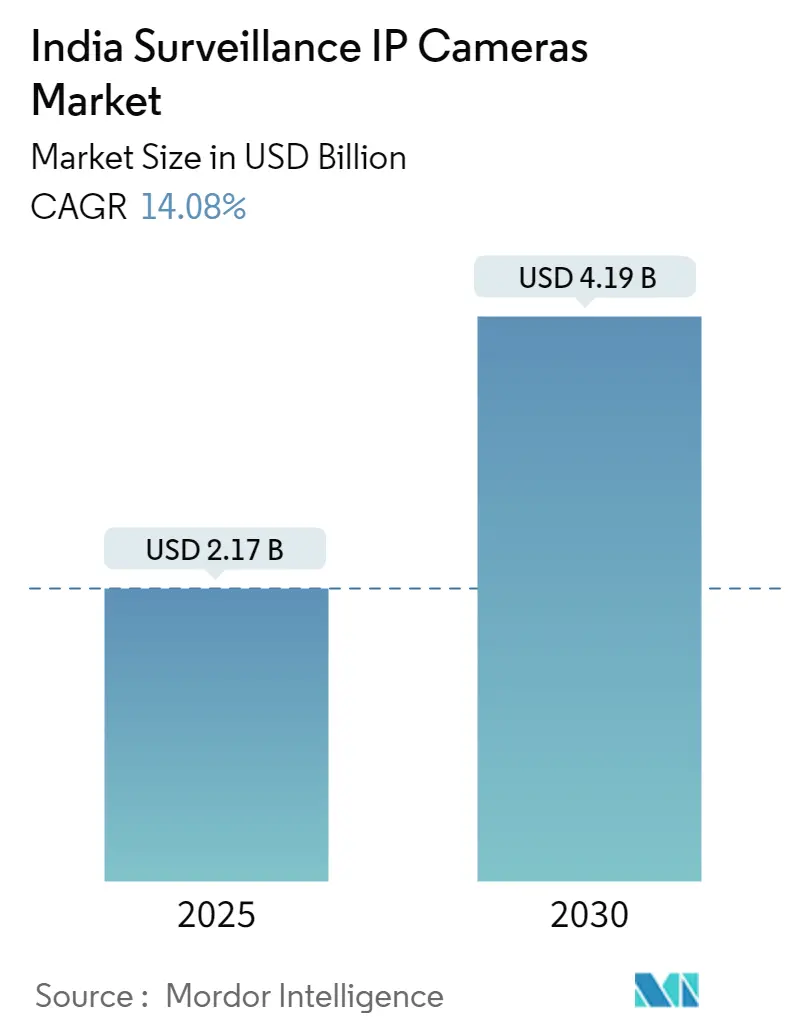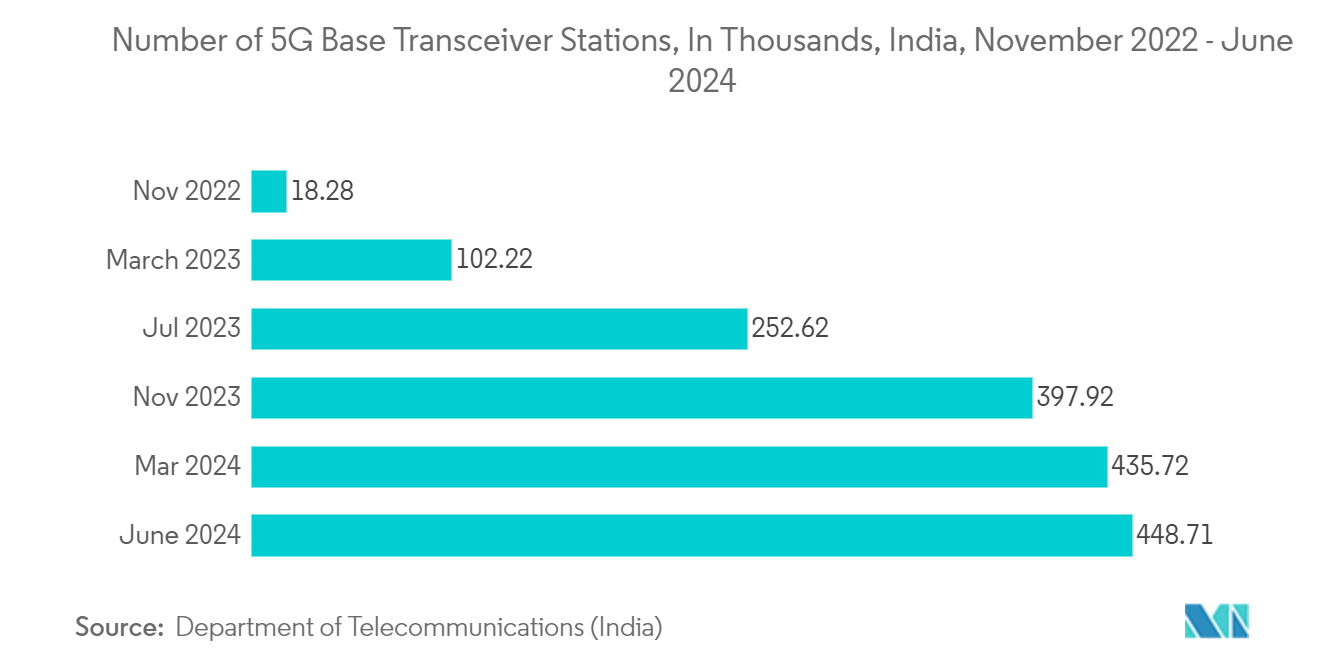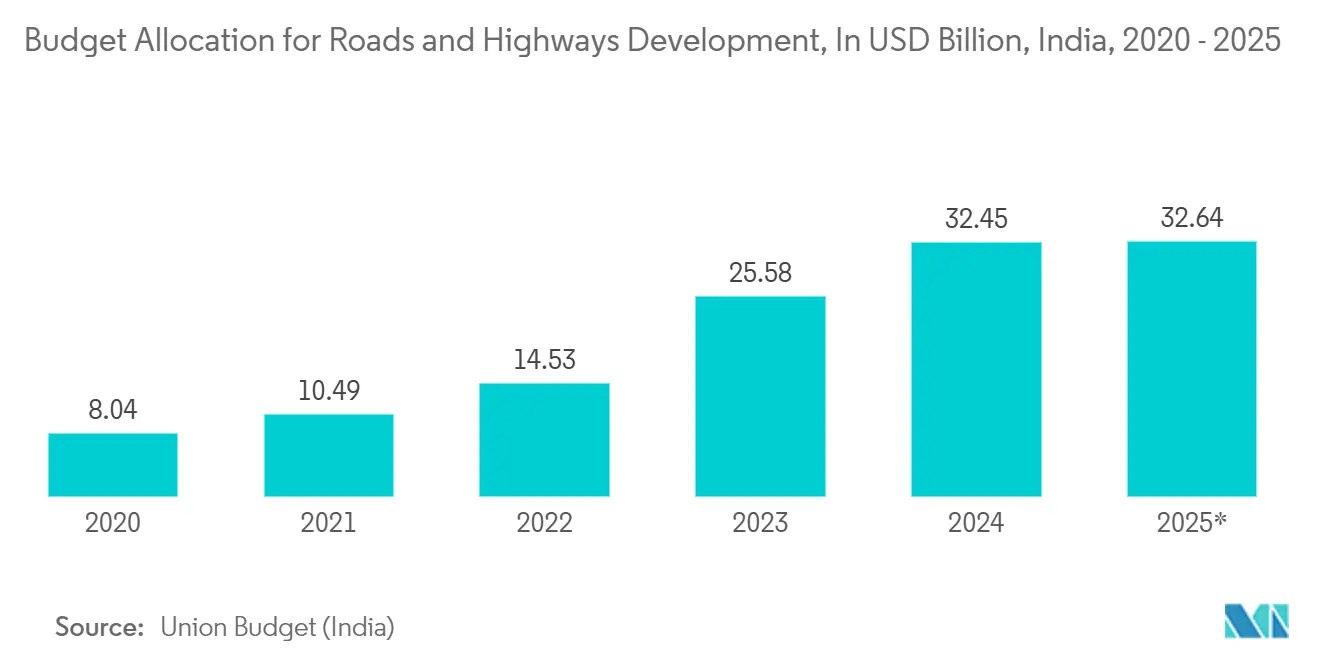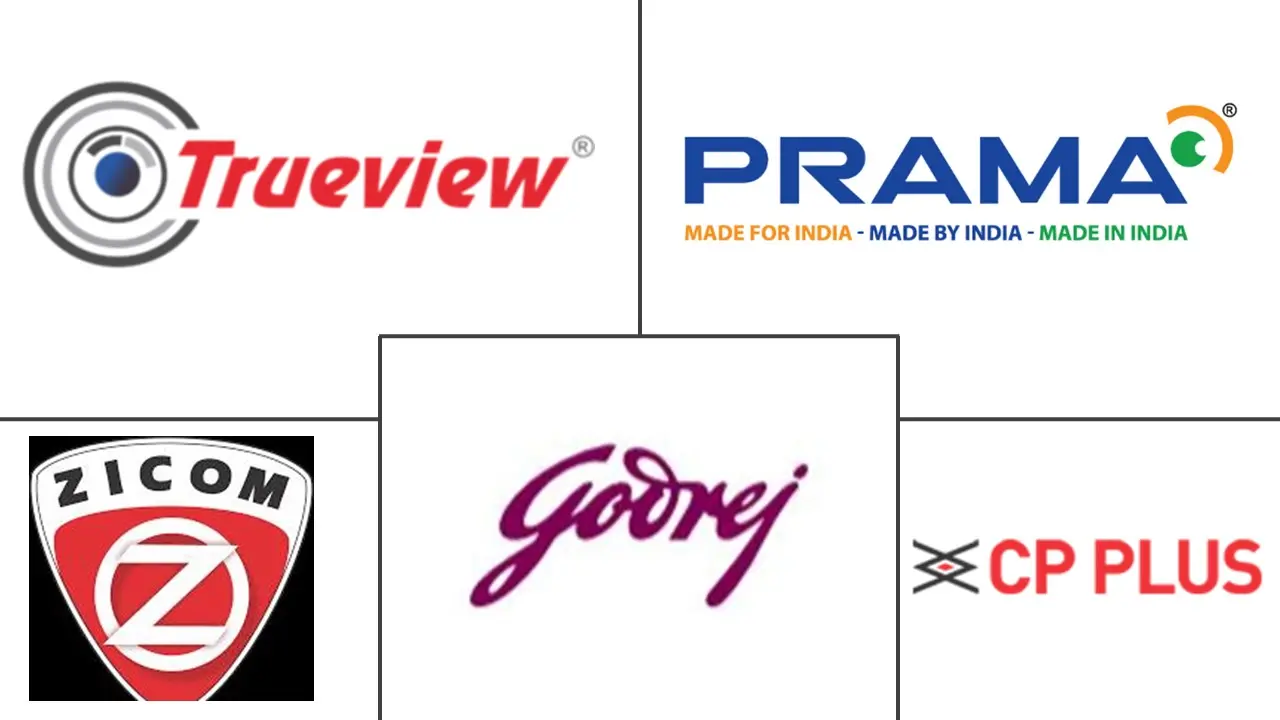India Surveillance IP Cameras Market Size and Share

India Surveillance IP Cameras Market Analysis by Mordor Intelligence
The India Surveillance IP Cameras Market size is estimated at USD 2.17 billion in 2025, and is expected to reach USD 4.19 billion by 2030, at a CAGR of 14.08% during the forecast period (2025-2030).
- India is poised to become a key player in the surveillance IP camera market, driven by rising infrastructure investments and mounting security challenges. Additionally, the nation's pivot toward digitization and smart city initiatives fosters a conducive environment for market expansion. Illustratively, the Indian government's commitment to its smart city agenda underscores this trend. With plans to establish 100 technologically advanced smart cities, the government has earmarked substantial funds for deploying IP cameras, emphasizing real-time monitoring and crime deterrence. These investments are integral to enhancing urban security and management in these cities.
- Rising crime rates in urban centers are fueling the demand for sophisticated surveillance systems, not only to deter criminal activities but also to aid in investigations. Escalating incidents of violence, particularly against women, have sparked social unrest, prompting the government to take decisive actions. Notably, several states in the country are witnessing alarming rates of crimes against women. The government is intensifying its efforts to combat these atrocities in response to mounting public pressure.
- The country has also launched the Safe City project, which focuses on women's safety in public places through the deployment of extensive surveillance networks in places such as Uttar Pradesh, Delhi, Mumbai, and many more. This involves installing IP cameras at strategic locations and integrating them with central monitoring systems. In 2023, the UP government launched the Safe City Project, instructing 17 municipal corporations and 2,500 schools in Gautam Buddha Nagar to install CCTV cameras.
- Government initiatives such as Digital India and Make in India aim to promote local manufacturing, which includes technologically advanced surveillance cameras, digital infrastructure, and connectivity. These initiatives aim to support the growth of IP surveillance by enhancing network capabilities and data management.
- Several local companies in the region have emerged as key players in the production of advanced surveillance IP cameras. These firms are not only localizing the manufacturing process but also ensuring affordability for the Indian consumer base. While cost is a significant consideration, especially for budget-conscious small businesses, the appeal of these locally produced IP cameras is on the rise, even when compared to traditional analog options. This shift is notably expanding the market, with more individuals opting for these IP solutions. The surge in awareness regarding home security is further fueling this trend, prompting homeowners to opt for network cameras, enabling remote monitoring.
- However, the market faces a notable challenge, i.e., a growing public unease with the widespread use of surveillance cameras. Concerns primarily revolve around potential misuse, unauthorized surveillance, and infringements on personal privacy. Moreover, ensuring the protection of data collected by these IP cameras adds another layer of complexity to the situation.
India Surveillance IP Cameras Market Trends and Insights
Improved Network Infrastructure is Driving the Market
- India's rapid adoption of surveillance IP cameras owes much to the country's concerted efforts in bolstering its network infrastructure. With advancements in network technology, surveillance solutions have become more efficient and scalable, effectively meeting the heightened security needs of diverse sectors.
- Moreover, the proliferation of high-speed internet and broadband services has facilitated the widespread deployment of IP surveillance systems. As internet penetration in India continues to soar, an increasing number of users and businesses are harnessing advanced surveillance technologies, notably IP cameras, which rely on consistent internet connectivity for optimal performance.
- The Indian government has initiated multiple programs to enhance urban infrastructure, investing billions toward this goal. This concerted effort not only upgrades the infrastructure but also facilitates the seamless integration of surveillance IP cameras. In tandem, governments throughout the region are heavily investing in smart city projects, with a strong emphasis on enhancing public safety and urban management, largely through the deployment of surveillance systems.
- For instance, in July 2024, India's Union Housing and Urban Affairs Ministry revealed that 100 cities successfully executed 7,188 projects, representing 90% of the total projects outlined in the mission. The cumulative investment for these endeavors stood at a substantial INR 1,44,237 crore (equivalent to USD 17.22 billion). These investments are bolstering city infrastructure, increasing reliability, and fueling demand for surveillance IP cameras.
- Data from the Department of Telecommunications highlights a remarkable 24-fold surge in 5G base transceiver stations in under two years, spanning from November 2022 to June 2024. As such, India's relentless push to enhance its network infrastructure is poised to be a key driver of the market's future expansion. As India's digital ecosystem evolves, major strides such as the rollout of 5G, extensive IoT integration, enhanced data transmission and storage, a fortified mobile network, and the rapid growth of data centers are set to propel the market significantly.

The Government Segment Witnessing Notable Growth in Demand
- The Indian government has launched several initiatives to strengthen the country's surveillance infrastructure. Supporting these efforts, the Production Linked Incentive (PLI) Scheme promotes domestic manufacturing of electronic components, including surveillance equipment. Furthermore, the 'Make in India' initiative has spurred the emergence of local companies producing high-quality surveillance cameras in India.
- For example, Prama India has a manufacturing facility in Mumbai that manufactures high-quality video security products according to Indian standards and market requirements. Many domestic companies, such as Zicom, Sparsh, Secureeye, Godrej, and CP Plus, make these products accessible to Indian consumers at affordable prices, which, in turn, drives the market.
- Recognizing the efficacy of surveillance IP cameras, the government is increasingly turning to them for enhanced traffic management. In Guwahati, India, the traffic police deployed integrated traffic management system (ITMS) cameras to curb traffic rule violations. Leveraging standard surveillance IP cameras, the ITMS captures videos for analysis. The police reported an average collection of around USD 18,000 from violators since the ITMS installation. In a notable move, the Delhi government, in December 2023, announced the installation of over 246,000 surveillance cameras in its 70 assembly constituencies. This is part of the city's ambitious CCTV project, spearheaded by the Public Works Department, which aims to have 280,000 cameras citywide.
- Recently, the Delhi Transport Department has also announced plans to roll out over 5,000 cameras as part of its Intelligent Traffic Management System, primarily aimed at reducing traffic violations. This move aligns with a growing trend in states like Uttar Pradesh and Kerala, as well as cities such as Jaipur and Kolkata, where IP cameras are becoming the norm for traffic oversight. With India's vast population, the uptake of ITMS is expected to skyrocket.
- The increasing number of infrastructures, especially in roadways and transportation, is also anticipated to drive the demand for IP cameras, given their pivotal role in efficient traffic management. In its Union Budget 2023, the Indian government allocated a substantial USD 25.9 billion for road and highway development. These developments are projected to create lucrative opportunities in the IP camera market.
- Furthermore, the increase in horrific crimes and assaults against women has led to social unrest, due to which the government is taking strict actions and installing surveillance cameras near educational institutions and critical places. For instance, in December 2023, the UP government launched the Safe City Project, mandating 17 municipal corporations and 2,500 schools to deploy CCTV cameras. Of these, 1,692 schools installed the cameras, with place for the rest. The regional government reports that by the end of 2023, a cumulative total of 26,568 CCTVs were operational in these establishments.

Competitive Landscape
The Indian surveillance IP camera market is fragmented, with major international and domestic players competing by offering technologically advanced products. The market features a wide range of manufacturers offering various technologies and solutions. Many companies compete in the market, offering various surveillance camera types and integration services. Some key market players include Dahua, Godrej Security Solutions, Prama India Private Limited, and CP Plus.
- August 2024 - Secureye, a provider of intelligent security solutions, unveiled its cutting-edge PHOENIX IP camera series in New Delhi. The company hailed the launch as a pivotal moment, emphasizing that the new camera boasts a suite of innovative features and broadens its range of IP cameras tailored for diverse applications.
India Surveillance IP Cameras Industry Leaders
-
Prama India Private Limited
-
Warner Electronics India Private Limited
-
CP Plus
-
Zicom
-
Godrej Security Solutions
- *Disclaimer: Major Players sorted in no particular order

Recent Industry Developments
- August 2024: Bosch Building Technologies, a leading provider of safety and security solutions, inaugurated its assembly line in India, specifically for video systems, debuting with the FLEXIDOME IP Starlight 5000i cameras. These cameras, boasting Bosch's cutting-edge AIoT technology, not only deliver advanced analytics and AI features but also come with detailed metadata. Crafted for versatility, they excel in both indoor and outdoor settings. In addition to their intelligent streaming and exceptional low-light performance, these cameras leverage efficient H.265 compression. Moreover, they feature a trusted platform model and an embedded firewall and hold cybersecurity certifications, ensuring top-tier data security and privacy.
- March 2024: The Ministry of Electronics and Information Technology (MeitY) issued a Public Procurement Preference to advance the “Make in India” initiative. This notification specifically addresses the procurement of CCTV and video surveillance systems for security purposes, establishing clear essential requirements (ER) for these devices. With the Central Government’s Cyber Security Certification norms for the Internet of Things, IoT products, starting with CCTV cameras, were set to kick in from June 2024. Two video surveillance equipment manufacturers from India, including Sparsh CCTV, bagged “IoTSCS [IoT System Certification Scheme] Certification” for their IoT products (CCTV cameras) from the “Standardisation Testing & Quality Certification” body, making their entire product range cyber-secured.
India Surveillance IP Cameras Market Report Scope
A surveillance IP camera is a digital video camera used for monitoring and security purposes. Unlike analog cameras, IP cameras transmit data over a network, allowing for remote viewing and recording. They often feature high-definition resolution, motion detection, and advanced capabilities such as facial recognition, night vision, and integration with other smart devices.
The study tracks the revenue accrued through the sale of surveillance IP cameras by various players operating in India. The study also tracks the key market parameters, underlying growth influencers, and major vendors operating in the industry, which supports the market estimations and growth rates over the forecast period. The study further analyses the overall impact of macroeconomic factors on the market.
The Indian surveillance IP cameras market is segmented by end-user industry (banking and financial institutions, transportation and infrastructure, government and defense, healthcare, industrial, retail, enterprises, residential, and other end-user industries). The market sizes and forecasts are provided in terms of value (USD) for all the above segments.
| Banking and Financial Institutions |
| Transportation and Infrastructure |
| Government and Defense |
| Healthcare |
| Industrial |
| Retail |
| Enterprises |
| Residential |
| Other End-user Industries |
| By End-user Industry | Banking and Financial Institutions |
| Transportation and Infrastructure | |
| Government and Defense | |
| Healthcare | |
| Industrial | |
| Retail | |
| Enterprises | |
| Residential | |
| Other End-user Industries |
Key Questions Answered in the Report
How big is the India Surveillance IP Cameras Market?
The India Surveillance IP Cameras Market size is expected to reach USD 2.17 billion in 2025 and grow at a CAGR of 14.08% to reach USD 4.19 billion by 2030.
What is the current India Surveillance IP Cameras Market size?
In 2025, the India Surveillance IP Cameras Market size is expected to reach USD 2.17 billion.
Who are the key players in India Surveillance IP Cameras Market?
Prama India Private Limited, Warner Electronics India Private Limited, CP Plus, Zicom and Godrej Security Solutions are the major companies operating in the India Surveillance IP Cameras Market.
What years does this India Surveillance IP Cameras Market cover, and what was the market size in 2024?
In 2024, the India Surveillance IP Cameras Market size was estimated at USD 1.86 billion. The report covers the India Surveillance IP Cameras Market historical market size for years: 2019, 2020, 2021, 2022, 2023 and 2024. The report also forecasts the India Surveillance IP Cameras Market size for years: 2025, 2026, 2027, 2028, 2029 and 2030.
Page last updated on:
India Surveillance IP Cameras Market Report
Statistics for the 2025 India Surveillance IP Cameras market share, size and revenue growth rate, created by Mordor Intelligence™ Industry Reports. India Surveillance IP Cameras analysis includes a market forecast outlook for 2025 to 2030 and historical overview. Get a sample of this industry analysis as a free report PDF download.



